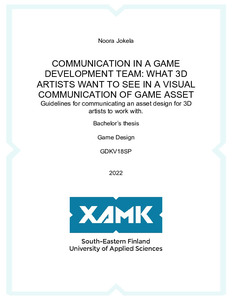COMMUNICATION IN A GAME DEVELOPMENT TEAM: WHAT 3D ARTISTS WANT TO SEE IN A VISUAL COMMUNICATION OF GAME ASSET
Jokela, Noora (2022)
Julkaisun pysyvä osoite on
https://urn.fi/URN:NBN:fi:amk-202205128824
https://urn.fi/URN:NBN:fi:amk-202205128824
Tiivistelmä
Sometimes lack of knowledge of what the 3D artist needs to see causes unnecessary relapses and bottlenecks which slow down the game production. The main objective of the thesis was to create general guidelines for communicating asset ideas and designs efficiently to a 3D modeler, focusing on visual communication. Methods such as a survey and a case study were used to research what 3D modelers of the game industry want to see in the visual communication of the asset design which is used as a reference for modelling the asset. To understand both sides of the communication, the aim was to find out what the person who communicates the idea for the 3D artist, sees as important to be paid attention to in the visual communication. In addition, areas of the industry were investigated such as the structure of job titles and methods around the communication of an idea.
The knowledge gained from thematic analysis of the survey answers and case study were used to create guidelines which contain three different methods. A method is chosen, according to the needs of one’s project and working methods. The guidelines were tested by selecting the most fitting guideline for creating an
asset for a roughly designed student game project.
The study found out what methods and opinions professionals in the industry have, what methods are preferred and how the structure of a production pipeline affects the communication methods. The study led to a conclusion that asset development is an iterative process and often the pipeline is designed to contain relapses, thus excluding a need for a method of zero relapses as well as need for perfect guidelines for visual communication of an asset for a 3D artist. However, the guidelines provide direction for clear and efficient communication which may reduce relapses caused by lack of knowledge. Additional testing and development of the guidelines are required.
The knowledge gained from thematic analysis of the survey answers and case study were used to create guidelines which contain three different methods. A method is chosen, according to the needs of one’s project and working methods. The guidelines were tested by selecting the most fitting guideline for creating an
asset for a roughly designed student game project.
The study found out what methods and opinions professionals in the industry have, what methods are preferred and how the structure of a production pipeline affects the communication methods. The study led to a conclusion that asset development is an iterative process and often the pipeline is designed to contain relapses, thus excluding a need for a method of zero relapses as well as need for perfect guidelines for visual communication of an asset for a 3D artist. However, the guidelines provide direction for clear and efficient communication which may reduce relapses caused by lack of knowledge. Additional testing and development of the guidelines are required.
